Les Parents Terribles [The Storm Within] (1949)
By Toronto Film Society on April 10, 2022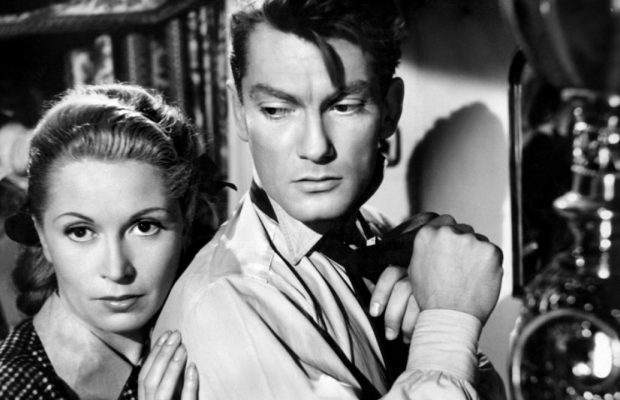
Toronto Film Society presented Les Parents Terribles [The Storm Within] (1949) on Monday, April 11, 1954 as part of the Season 6 Main Series, Programme 9.
NINTH EXHIBITION MEETING – SIXTH SEASON
Sunday, April 11, 1954 8.15 p.m.
Towne Cinema – 57 Bloor Street East
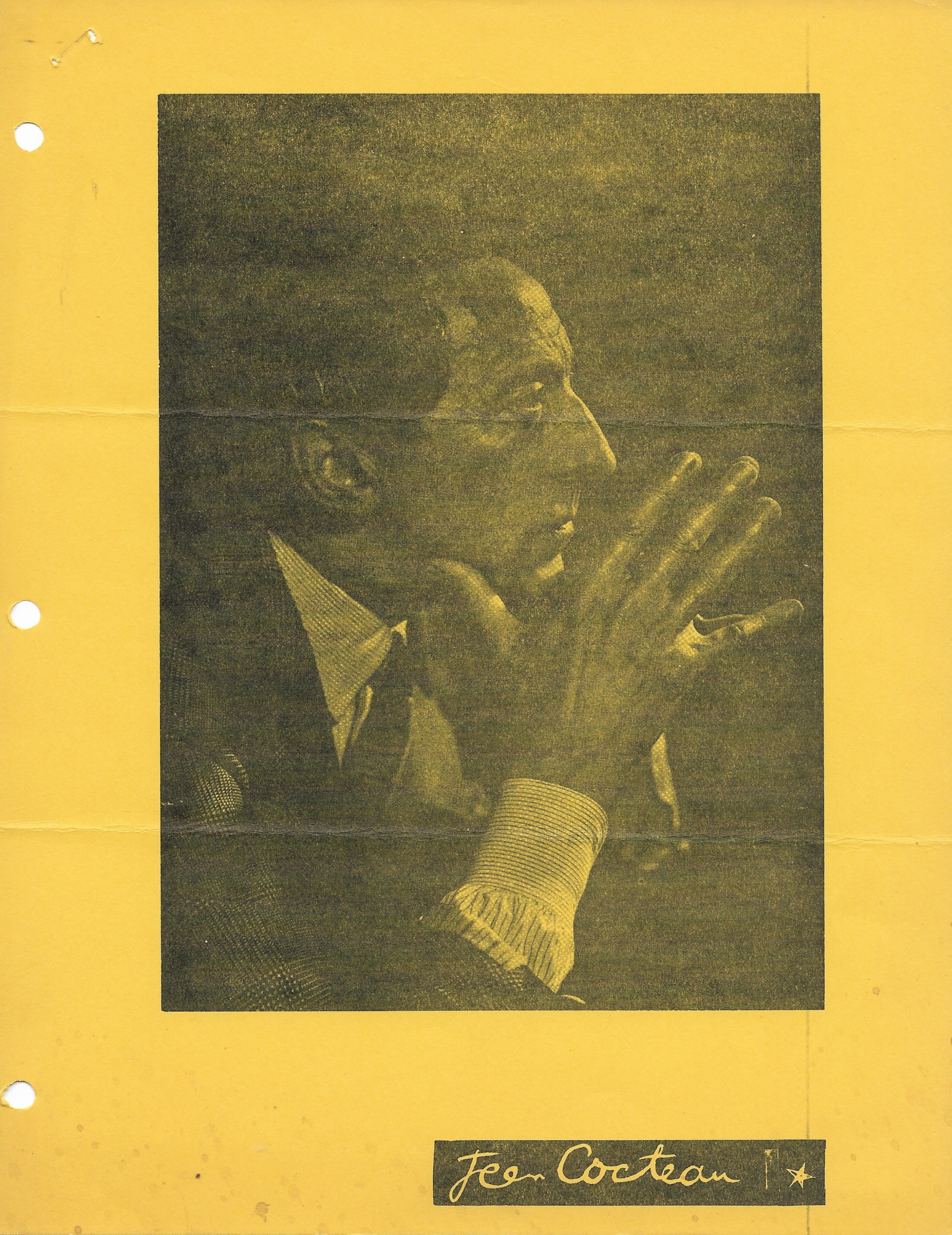
Rooty Toot Toot U.S.A. 1952 7 mins.
PRODUCTION COMPANY: UPA (United Productions of America)
PRODUCER: Stephen Bosustow
DIRECTOR: John Hubley
STORY: John Hubley and Bill Scott
DESIGN: Paul Julian
MUSIC: Phil Moore
UPA’s variation on the “Frankie and Johnnie” ballad. The design has incisive wit and elegance; the colouring–red for Frankie, blue for the superb Nellie Bly, grey, with black line drawing, for the bartender’s flashback–is as stylish as usual, emphasising detail rather than merely filling the screen. Clever balletic movements, an entertaining sound track and an agreeably satirical view of the conventional Hollywood court scene go to make up a sophisticated, highly enjoyable cartoon.
M.F.B. Nov. ’52
Struggle for Survival Sweden circa 1944 9 mins
Shortened version of Trut! (The Gull!)
by Arne Sucksdorff
for Svensk Filmindustri
Released theatrically in North America by Twentieth Century-Fox, Sucksdorff’s three films, People in the City, Shadows Across the Snow, and The Gull! were shortened to one reel each and re-titled.
At the time Sucksdorff ha finished a brief apprenticeship on documentaries, he had become, by choice and by temperament, a solo film-maker, writing, directing, photographing and editing short pictures that are as personal as poems. The first of his films to be a kind of melodrama of the animal world, The Gull! is a strange and savage picture of bird life on a barren island in the Baltic. It followed a group of first films which were idyllic in their view of nature and remarkable for the compositions of individual shots. In The Gull! an almost magical camera records the preying of the strong upon the weak, the havoc and terror brought by a single gull to a colony of guillemots. Sucksdorff made bold use of cutting, of close-ups and long shots, and the shrieking of birds on the sound track.
Sucksdorff’s ferocious and beautiful animal world has no parallel anywhere. The directness, freshness and poetry of his style are unique. He has denied that his nature films are to be interpreted as allegories of modern times. “Suckdorff is a seeker after truth. He seeks it in the whole of creation, in wildlife, and now, in human society”: (The Great Adventure, his first feature).
Peter Ericcson; Sequence 7;
Catherine de la Roche: Sight and Sound Oct./Dec. ’53.
The Romance of Transportation Canada 1952
PRODUCED by the National Film Board of Canada
PRODUCTION & DIRECTION: Tom Daly
SUPERVISION: Colin Low
PHOTOGRAPHY: Lyle Enright
MUSIC: Eldon Rathburn
NARRATION: Guy Glover
SOUND EDITING: Ken Heeley-Ray
SOUND RECORDING: Clarke Daprato
ANIMATION: Wolf Koenig (characterization); Robert Verral (Design); Sidney Goldsmith, Barrie Helmer (assistants).
This Canadian production which took the prize for animated films in Cannes in 1953 is a completely charming piece of work, bringing to life the story of transport with no respect for the solemnities of history. Its skilled animation is comparable in quality with McLaren and UPA. The soundtrack is a combination of witty commentary, lovely melodies and delicious noises: the various honks, toots and kerplunks heard here and there were written into the musical score, just like the notes of any instrument.
Animator Wolf Koenig comments on the film
In making this film, we wanted to get away from the usual broad, impersonal views of history. Instead we wanted to tell about the development of Canada’s transportation system in terms of the people involved.
We could not have asked for a better subject to animate. A magnificent variety of modes of travel were at our disposal. Fast and slow, land and sea, foot and wing. Each method with its own period, its own purpose and alas, its own hazards. The visual part of the film deals with the problems of transportation encountered by people throughout Canada’s history and how they attempted to solve them.
With the commentary we meant to supply an ironic element in opposition to the picture. The commentator informs us of what happened in Canada’s transportation history without being aware of what happens on the screen.
The film is not slapstick comedy. It isn’t meant to roll an audience in the aisles. It is hoped, rather, that people will smile and that, in a small way, they will be informed about the romantic history of transportation in Canada.
Note on the Musical Score by Eldon Rathburn
The decision to use the modern dance style of music that was eventually recorded for The Romance of Transportation came about after many discussions: numerous other ideas were thought of, such as the use of early folk music, ballads with voice, and period music, but all were discarded. Finally, the dance style was decided on, and the orchestra chosen. This was made up of trumpet, clarinet, tenor sax, piano (celeste), bass, guitar, drums and vibraphone.
Different kinds of modern dance music were used. Bop was used for the titles and the hectic moments (traffic); Boogie Woogie with its rolling movement was decided on for the train episodes; the Blues was used in one section as counterpoint to the action (oxcart and driver); Swing style served for the stagecoach and canoe episodes.
The basic idea behind the music was that it should run parallel to the picture in its own manner, rather than imitate it.
Notes by Koenig and Rathburn from Ottawa Film Society Programme Notes, January 18, 1953
Les Parents Teribles [The Storm Within] (1949)
DIRECTOR: Jean Cocteau
SCRIPT: Jean Cocteau, from his own play
PHOTOGRAPHY: Michel Kelber
DESIGNS: Christian Berard
SETS: Guy de Gastyne
EDITOR: Mme. Douarinou
MUSIC: Georges Auric
CAST: Yvonne de Bray (Sophie), Jean Marais (Michel), Gabrielle Dorziat (Léonie), Josette Day (Madeliene), Marcel André (Georges).
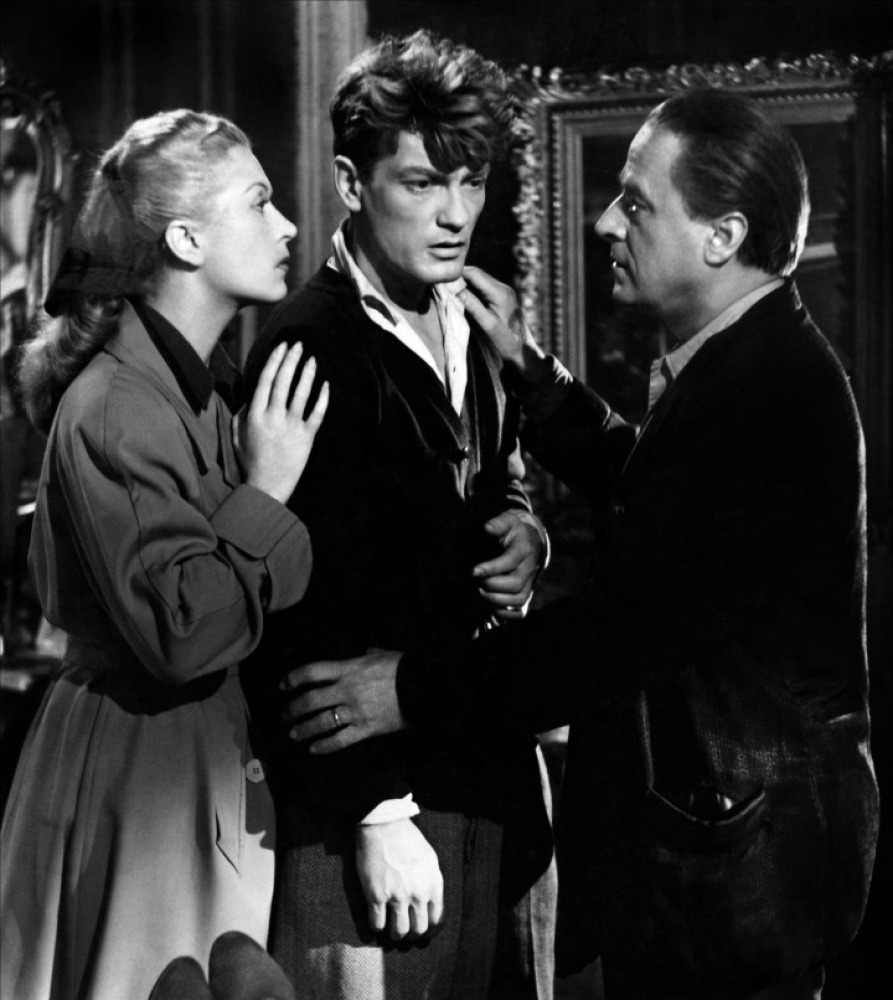
Les Parents Terribles has twice been a milestone in Jean Cocteau’s career. When writing the play in 1938 he was abandoning the mythological themes and eccentric décors in favour of a modern subject denuded of all scenic elaborations. As he explains in his preface–and his prefaces are always enlightening–he wished to portray a contradictory, unpredictable family, typical of ‘a society adrift’, while giving his play direction and unity. The result was a concentrated drama, resting on the ever-serviceable foundation of a vaudeville plot.
In 1949 he transferred this play, practically unaltered, to the screen. Paradoxical though it may seem, this was the picture that revealed him as a master of the film medium….. The subsequent Orphée (shown last Season) is undoubtedly his masterpiece. Nevertheless, Les Parents Terribles, with its utterly different content, remains unique, uneclipsed and in many ways as memorable. (Catherine de la Roche)
Cocteau writes: “The mechanism of the action is that of a drama and a vaudeville, which provokes a mixture of drollery and tears, those great waves of silence and laughter, sometimes cruel, which alternate at full speed in the innumerable theatres to which my five artists have brought their caravan. Caravan, gypsies, strolling players–it is of these that the childlike family makes us think, those still-innocent beings who act like blind and deaf creatures, with the exception of Aunt Leo whose behaviour remains an enigma to me, for her character took shape by itself while I was writing the play, and is no clearer to me than it must be to her, as often happens with people who repress maternal tenderness and love.”
As things go in a world of complexes and fixations, these (five characters) are commonplace people in commonplace situations…. To give their story continuity of action and a note of comedy, Cocteau compressed it into a contrived plot, not scorning coincidences. Thus, his characters behave logically in illogical circumstances. ….This method of constructing drama may be a compromise, but in this case it has been singularly successful on the stage and screen because the characters and interlocking themes are so rich that the artificiality of the incident hardly matters. The mother, sick in mind and body, her sister who hated her until she drew strength from a sense of superiority, the son, almost content in his idleness and näivete–all the characters are shown as products of their past and one another’s influence, capable of erratic changes, yet consistent in their dominating motives. (de la Roche)
Cocteau again: “I wished to try to solve the problem of transferring the theatre to the screen and of filming a play, that is, of keeping it intact, walking invisibly among my protagonists (with the camera) while observing their expressions closely and lifelike, following the into the rooms and corridors of an apartment which the laws of the theatre limit to a single room.”
On the stage there were two sets: the mother’s gloomy, chaotic bedroom and Madeleine’s bright and tidy living-room. In the film they are extended to show the remainder of the two homes, but the characters are never seen outdoors–their enclosed surroundings typify their self-centred existence. They have more freedom of movement, but Cocteau never shifts them about without a practical or emotional motive…..
Cocteau did not use the advantages of the film medium for adding fluidity to the mise en scène so much as for selection and emphasis. Especially emphasis through exclusion. Cutting and close-ups were more suitable for catching the enormous amount of mimicry than camera movement. There is the famous close-up when Michel first tells his mother about Madeleine, for instance. His head is above hers, and only his mouth, speaking with a smile, and her eyes, becoming terrible, are seen in the frame. …. As in all his films, … Cocteau has been resourceful in devising suggestive sound effect. When, for example, Léonie tells Yvonne about her former hatred, the menacing noise of a fire-engine is heard from outside, fading away as her tale softens in tone.
The stage origin of Les Parents Terribles remains perceptible, but this does not diminish its interest and vitality as a brilliant piece of cinema. The picture is an integrated whole, the work of a single controlling artist who has imposed his style upon it. Distinguished colleagues who have often collaborated with him and understand him, contributed greatly to its success, notably the late Christian Bérard the designer, and Georges Auric, the composer. (de la Roche)
The whole play is designed for great acting by great actors. In the film the acting is uniformly brilliant, dominated by Yvonne de Bray’s horrifyingly real and anguished study of obsession, and with a performance of great subtlety and character by Gabrielle Dorziat. (Lambert)
Sources: Cinema 1951 – Catherine de la Roche’s review
Monthly Film Bulleting (British Film Institute)
April-May 1951 – Gavin Lambert’s review
THINGS TO COME
Members may be interested to know that around Easter time, three Odeon theatres (the Danforth, Fairlawn and Humber) will be showing White Mane, the English version of a French film entitled Crin Blanc which has received fine reviews and several awards abroad. This will be shown on the same bill with Lazar Wechsler’s Heidi.
Also the same week, the Odeon-Hyland will be offering The Kidnappers, a British movie about early Nova Scotia that from all reports should be worth a visit. This film was made by Philip Leacock, director of last year’s memorable The Brave Don’t Cry.
MEMBERS’ EVALUATIONS
ON My Apprenticeship:
“A film of stimulating interest; strong feeling of vibrant, eager life in spite of depressed social conditions; character studies and depiction of types who make up the child’s world; opportunity of seeing what would appear to be authentic social and economic conditions of the period; would probably have found it overlong if I had not recently seen the first part of the trilogy”—“Very moving; liked understanding of human beings; but too long and somewhat repetitious”—“Depressing”—“N.G.”—“Very interesting for view of Russian life, but completely lacking in subtlety; atrocious sound track”—“A unique Russian film; its picture of people, warm and human; its picture of conditions of the times, restrained, subtle, no over-emphasis for political propaganda; its sound track and photography; tempo just right, measured unfolding; dances and songs integral part of story, not laid on”—“Not as good as Childhood; too long”—“Most enjoyable; the philosophy expressed, the superb acting”—“Excellent direction”—“Very fine; beautiful character portrayal”—“Excellent; hope to see concluding part of Gorki’s life next season; actors seemed natural and human, unlike caricature types seen in Hollywood versions of great personalities and writers”—“Acting of sympathetic characters good, but bourgeoisie an soldiery are Dickensian caricatures, somewhat outmoded; but incidents well chosen to show influences to which he was exposed, and well knit together”—“By our Western standards I suppose it was pretty poor but fascinated by the Russian life, the wonderful fantastic characters who were just “being” and not acting; the scenes on the Volga; the sense of pullulating humanity so abandoned to the emotion of the moment; like living in a Russian novel”—“After seeing Childhood it was like renewing acquaintances with old friends; seeing the first film added immeasurably to enjoyment of Apprenticeship; casting wonderful; every scene so spontaneous, gives feeling you are watching reality”.
ON Facts and Fancies:
“Excellent; liked fantasy touch and treatment of usually dry statistics”—“An attempt to liven up the usual fact film; unfortunately the technique became as tiresome as the straight treatment usually is!”—“Very interesting; trick photography amusing and imaginative”—“Wonderful! it really burlesqued the documentaries on industrial processes”—“A relief not to be pontificated at, but a bit too slick and tricky, also practically defeating its own ends!”—“Rather boring; ideas good but overworked by repetition”—“Interesting to a point, but have been given no desire to know more about gas”—“Original, wonderful satire; presents message in an underhand way!; more Massinghams, please”.
ON Images Pour Debussy:
“Enjoyed this; very pleasant and a fine print”—“Almost completely lacking in rhythm sense”—“Very soothing and restful both in sight and sound; photography excellent”—“Dreadful nonsense; unrelated, jumbled splotches of black and white; completely pointless; sound poor”—“Too banal & wildly trying on the eyes!”—“Very pleasant to watch”—“Pretty”—“Some really lovely effects but my eyes could not accommodate to rapidity of change; a physical impossibility to view this film”—“Like H20; I’ve had enough of this sort of film; I surrender! Just stop showing them”.
CURRENT FILMS
David Lean, whose films in recent years have tended to be rather chilly showcases for an accomplished technique, happily returns to the contemplation of human beings in Hobson’s Choice–his most satisfying work since Great Expectations. From Harold Brighouse’s stage comedy he has fashioned a warmly humorous film, rich in character and atmosphere and blessed with distinguished performances. John Mills crowns an honorable career with a capital characterization as the talented but exploited employee of a bootmaker, whose enterprising and determined daughter marries him, sets him up in business and makes him a personage in spite of himself. Brenda de Banzie, a highly welcome newcomer is superb as the daughter; while Charles Laughton bids fair to start a whole new screen career for himself with his mellow, knowing job as the tippling, stubborn and reactionary old father. Mr. Lean’s way with a camera is as skilled as ever, and altogether you won’t go wrong in making Hobson’s Choice your own for a royal evening’s entertainment.
Another rare treat of a decidedly different kind is to be found in The Living Desert, Walt Disney’s feature-length “True-Life Adventure” film–a completely fascinating existence between the assorted animals, insects, birds and reptiles that dwell there. The remarkable footage has been brilliantly edited and scored to create alternating moods of terror, humor and beauty. Mr. Disney richly deserves his Academy Award for this tour-de-force, but must share the credit generously with director James Algar and the gifted, painstaking cameramen who got the amazingly close and detailed shots of this strange and enthralling world. I thought it unfortunate that this achievement was shown on the same bill with Disney cartoon called Ben and Me, a deplorable affair that reduces Benjamin Franklin to a typical Disney ditherer and dodderer and his newspaper to the level of a scandal sheet, presents a Thomas Jefferson with the appearance and accents of a thug, and instructs us that the more important decisions and utterances of these gentlemen were in reality inspired by a small mouse domiciled with Mr. Franklin. It has long amazed me that the same film-maker is capable of such brilliance and such vulgarity.
Turning to worthier things, George More O’Ferrall has made a sincere and earnest attempt to film Graham Greene’s The Heart of the Matter. The movie obviously hasn’t the time the novel had to fully explore the characters’ motivations and relationships, and the mending has had to be altered–but still it’s an unusually adult screen drama, always interesting and sometimes moving, about a British Colonial administrator whose personal convictions of right and wrong increasingly run counter not only to his Empire’s laws but to those of his Church, the Roman Catholic. Fine performances by Trevor Howard in this tortured and difficult role, Maria Schell and the others. A less pretentious, so more successful British picture is The Intruder, an excellent script well handled by a promising new director, Guy Hamilton. Concerning an ex-Army officer and his post-war encounters with a number of his men (particularly one who has turned thief) it employs the “chase” theme and the multiple-flashback technique on an intelligent level; has humor, insight and compassion, and is acted with great persuasiveness by Jack Hawkins, Michael Medwin and the rest.
In Beat the Devil, an Italian-made take-off on his own Maltese Falcon, John Huston (with the aid of Truman Capote) tries awfully hard to be smart and sophisticated but I’m afraid it doesn’t quite come off. It’s “different” all right, provides a certain number of laughs and has a strong cast (Bogart, Jennifer Jones, Robert Morley, etc.) but it seems a sorry, rambling affair when one recalls the masterly authority and tight construction of The Maltese Falcon, The Treasure of the Sierra Madre, and The Asphalt Jungle, or the poetic insight of The Red Badge of Courage. Frankly I think that John-boy should head for home where he did all his best work.
George G. Patterson
You may also like...
-
News

Frances Blau
Toronto Film Society | February 27, 2024On Monday, February 26th, 2024, Toronto Film Society lost longtime friend, supporter, and board member Frances Blau. Known for her sense of humour, her love of film, her generosity,...
-
Special Events

Arsenic and Old Lace (1944) at the Paradise Theatre
Toronto Film Society | April 21, 2024Toronto Film Society presents Arsenic and Old Lace (1944) at the Paradise Theatre on Sunday, May 5, 2024 at 2:30 p.m. Screwball comedy meets the macabre in one of...
Programming

Virtual Saturday Night at the Movies
Toronto Film Society | April 11, 2024Toronto Film Society is back in the theatre! However, we’re still pleased to continue to bring you films straight to your home! Beginning Season 73 until now we have...
4-
 Toronto Film Society | April 21, 2024
Toronto Film Society | April 21, 2024
-
 Toronto Film Society | November 6, 2022
Toronto Film Society | November 6, 2022
-
 Toronto Film Society | August 1, 2023
Toronto Film Society | August 1, 2023
Donate to Toronto Film Society – We’re now a Registered Charity!
-
Copyright © 2017 Toronto Film Society.

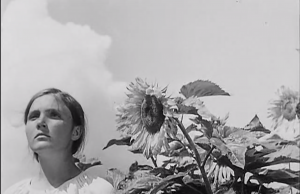
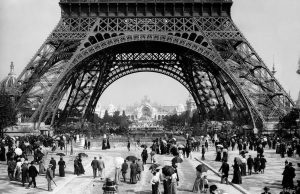
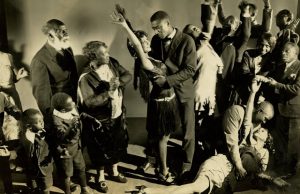
Leave a Reply